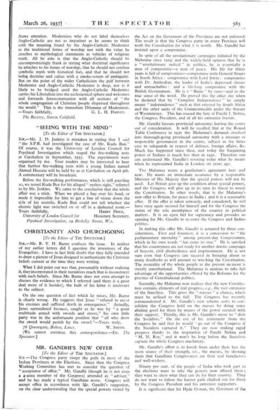THE DILEMMA OF MODERNISM
[To the Editor of THE SPECTATOR.] SIR,—The Dean of St. Paul's does not push his analysis of Anglican Modernism far enough. He divides it into two sections deriving repectively from Liberal Protestantism and Roman Catholic Modernism. His illustrious predecessor, Dr. Inge, discussed Roman Modernism in a sermon preached before the University of Oxford in 19°4. " The genius of the Church," he said, " is identified with the -Holy Spirit of God, and Catholic tradition becomes Christ Himself, reincarnated in each generation within the historic Church." What is meant by the historic Church is here a question of crucial importance. The Roman Modernist has no shadow of doubt. It is that august institution which has its head and centre in Rome. To the Roman Modernist the institution of which the Dean of St. Paul's is so distinguished an ornament was no more a part of that Church than are the Presbyterian and Methodist Churches. If a child of Roman Modernism, Anglo-Catholic Modernism is but a bastard child. Its putative father would have denied paternity with some indignation.
The Anglo-Catholic Modernist is out of line with Roman Modernism in that he belongs to a Church which defines Christ's holy Catholic Church as nothing less than " the whole congregation of Christian people dispersed throughout the world." The Liberal Evangelical and the Modernist sans phrase find no embarrassment in this. They recognise the great non-episcopal churches as true churches possessing valid ministries of the word and sacraments. Their Liberalism is ecclesiastical as well as doctrinal. The Catholicism of Anglo-Catholics, Modernisk or otherwise, is narrow and more hesitant. It attaches great importance to the possession of what is described as " the apostolic succession." It is open to the same criticism as that directed by Dr. Inge against Roman Modernism when he said, " A Church must prove its moral and spiritual descent from the life and teaching of its Founder. External continuity is not disputed, and proves nothing."
Here is a distinction which eludes Dr. Matthews' analysis, and is more fundamental than the distinctions to which he draws attention. Modernists who do not label themselves Anglo-Catholic are not as impatient as he seems to think with the meaning found by the. Anglo-Catholic Modernist in the traditional forms of worship nor with the value he attaches to mythological statements as vehicles of religious truth. All he asks is that the Anglo-Catholic should be uncompromisingly frank in stating what doctrinal significance he attaches to his forms of worship, that he should not confuse symbolic myth with historical fact, and that he should not befog doctrine and cultus with a smoke-screen of ambiguity. But on the point of the wider Catholicism the gulf between Modernist and Anglo-Catholic Modernist is deep, nor is it likely to be bridged until the Anglo-Catholic Modernist carries his Liberalism into the ecclesiastical sphere and welcomes and forwards Intercommunion with all sections of " the whole congregation of Christian 'people dispersed throughout the world." This is the immediate Dilemma of Modernism.
—Yours faithfully, G. L. H. HARVEY. The Rectory, Sutton Goldfield.











































 Previous page
Previous page